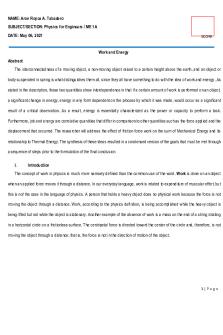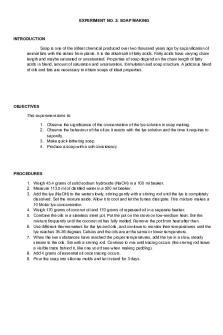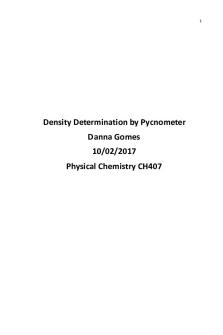PHY1ME1A Laboratory Report 5 Tabadero Aron Royce PDF

| Title | PHY1ME1A Laboratory Report 5 Tabadero Aron Royce |
|---|---|
| Course | College Physics 1 |
| Institution | Pangasinan State University |
| Pages | 28 |
| File Size | 1.5 MB |
| File Type | |
| Total Downloads | 75 |
| Total Views | 143 |
Summary
For Academic Purposes....
Description
NAME: Aron Royce A. Tabadero SUBJECT/SECTION: Physics for Engineers / ME 1A DATE: May 06, 2021
SCORE
Work and Energy Abstract The interconnectedness of a moving object, a non-moving object raised to a certain height above the earth, and an object or body suspended in spring is what distinguishes them all, since they all have something to do with the idea of work and energy . As stated in the description, these two quantities show interdependence in that if a certain amount of work is performed on an object, a significant change in energy, energy in any form dependent on the process by which it was made, would occur as a significant result of a critical observation. As a result, energy is essentially characterized as the power or capacity to perform a task. Furthermore, job and energy are correlative quantities that differ in comparison to other quantities such as the force applied and the displacement that occurred. The researcher will address the effect of friction force work on the sum of Mechanical Energy and its relationship to Thermal Energy. The synthesis of these ideas resulted in a condensed version of the goals that must be met through a sequence of steps prior to the formulation of the final conclusion I.
Introduction
The concept of work in physics is much more narrowly defined than the common use of the word. Work is done on an object when an applied force moves it through a distance. In our everyday language, work is related to expenditure of muscular effort, but this is not the case in the language of physics. A person that holds a heavy object does no physical work because the force is not moving the object through a distance. Work, according to the physics definition, is being accomplished while the heavy object is being lifted but not while the object is stationary. Another example of the absence of work is a mass on the end of a string rotating in a horizontal circle on a frictionless surface. The centripetal force is directed toward the center of the circle and, therefore, is not moving the object through a distance; that is, the force is not in the direction of motion of the object.
1|Page
II.
Materials and Methods
MATERIALS/EQUIPMENTS In this laboratory report, I used my phone, personal computer, internet connection, and those virtual activity for me to accomplish the given tasks. In this laboratory report we are given different types of virtual activity that is connected to work and energy, it help us to understand it very well. All we need to do is to accomplish the given task to gain knowledge and to learn on this activity by doing the activity given on the simulation and it is also the instrument to answer the given question on the activity. Materials/Equipment 1. Work and Energy Physics Simulator Instruction 1. Visit the link provided in each Procedure. 2. Follow the procedures indicated in the Activity of each simulator. Answer the given activities. 3. Take a screenshot for each gathered data foreach simulation. 4. Compile and Label this Screen Shots in the Appendices Section 5. Discuss the Results of each Simulation Activity in the Results Section 6. Attach the answered activity forms for each simulation in the appendices. III.
RESULTS
The tables I inserted and arranged here for better understanding of the activity results. These tables contain the date that is need for questions on the activity and I gathered all the results on the simulation about Work and Energy. This is a condensed version of the responses I received from the various topics and questions that I have encountered. Part 1: Its All Uphill Interactive
Angle (°)
Force (N)
Displacement (m)
Work (J)
30.0
19.6 N
2.0 m
39 J
40.0
25.2 N
1.6 m
4.0 x 10 J
50.0
30.0 N
1.3 m
39 J 2|Page
60.0
33.9 N
1.2 m
41 J
70.0
36.8 N
1.1 m
4.0 x 10 J
80.0
38.6 N
1.0 m
39 J
90.0
39.2 N
1.0 m
39 J
Part 2: Stopping Distance Initial Height
Pre-Collision Speed
Skid Distance
(cm)
(m/s)
(cm)
10.0
1.21
20.0
1.71
30.0
2.10
40.0
2.42
50.0
2.71
60.0
2.97
70.0
3.21
80.0
3.43
𝑚
10.0 cm
𝑚
25.0 cm
𝑚
35.0 cm
𝑚
48.0 cm
𝑚
60.0 cm
𝑚
72.0 cm
𝑚
85.0 cm
𝑚
98.0 cm
𝑠 𝑠 𝑠 𝑠 𝑠 𝑠 𝑠 𝑠
Part 3: Coaster Energy The Basic Energy Relationships behavior in the first part of Roller Coaster shows that the amount of kinetic energy is inversely proportional to the amount of potential energy. That is, as potential energy is released and decreases, kinetic energy rises, and vice versa. Despite the ramifications of the potential and kinetic energy relationships, the mechanical energy of the roller coaster car remains constant. The main explanation for this is that a system's total mechanical energy is the sum of its potential and kinetic energy. In the second segment, referred to as Hill Design, each point on the roller coaster track is adjusted to a specific height. The points can be seen with similar heights when viewed from a larger perspective. The graphs that show the amount of kinetic and potential energy of the roller coaster change as it moves, but the mechanical energy stays constant no matter where the roller
3|Page
coaster is. The potential energy graph shows that as the height of the position from which the roller coaster is situated increases, so does the potential energy. As a result, potential energy is proportional to height. On the other hand, as previously said, the amount of kinetic energy increases as the amount of potential energy increases, and vice versa. As a result, potential and kinetic energies are inversely proportional. Part 4: Energy Simulation In the masses and springs, The researcher had found that the Mechanical Energy of the increased as it was stretched and compressed away from the equilibrium point, as shown in the Energy Graph. The Gravitational Potential Energy decreases as the spring is extended by forcing the mass back, while the Elastic Potential Energy increases. When the mass is forced up, however, both Gravitational Potential Energy and Elastic Potential Energy increase, but only a small amount of Elastic Potential Energy increases, as shown by the Energy Graph. By incorporating this observation, it can be therefore concluded that stretching the spring by pulling the mass do more Work on the system compared to that of compressing it by pushing the mass up.
In the Energy Skate Park section, The behavior of the skater's motion and energies have been observed. The competent researcher can observe that the total Mechanical Energy is conserved throughout the entire trip of the skater along the skate track by assuming the exclusion of other external forces that can affect the behavior of the motion. It is also observed that as the skater approached the two top ends from the opposite side of the skate track, the Kinetic Energy became zero because the skater paused for a short period of time before changing direction of motion. On the other hand, as the skater approached the bottom of the skate track, his Kinetic Energy was at its peak. When it comes to Potential Energy, it works in the opposite direction of Kinetic Energy. It is the case that when the skater reaches the top two ends of the skate track, the Potential Energy is at its peak, while it is at its lowest when the skater reaches the bottom. In The Ramp section, Along the horizontal and inclined ramp, the knowledgeable researcher was about to observe the cabinet's motion, work, and energy. It has been noted that the cabinet's overall Mechanical Energy has risen over time as it has accelerated. Furthermore, since the ramp from which the cabinet moved is not raised to a certain height, its Potential Energy is zero, leaving only Kinetic Energy to contribute to the total amount of Mechanical Energy. Furthermore, because the ramp is horizontal and has no angle of inclination, the height is always zero at any point along it, and the same is true for the Potential Energy. 4|Page
IV.
DISCUSSIONS
In this laboratory report there are various formula that could help us on doings this type of activity and it also help us to understand more what energy and work is on this branch of science called physics. THE LAW OF CONSERVATION OF ENERGY The law of conservation of energy states that energy can neither be created nor destroyed - only converted from one form of energy to another. This means that a system always has the same amount of energy, unless it's added from the outside. This is particularly confusing in the case of non-conservative forces, where energy is converted from mechanical energy into thermal energy, but the overall energy does remain the same. The only way to use energy is to transform energy from one form to another. KINETIC ENERGY Kinetic energy, form of energy that an object or a particle has by reason of its motion. If work, which transfers energy, is done on an object by applying a net force, the object speeds up and thereby gains kinetic energy. Kinetic energy is a property of a moving object or particle and depends not only on its motion but also on its mass. The kind of motion may be translation (or motion along a path from one place to another), rotation about an axis, vibration, or any combination of motions. 𝑲=
𝟏 𝒎𝒗𝟐 𝟐
POTENTIAL ENERGY Potential energy arises in systems with parts that exert forces on each other of a magnitude dependent on the configuration, or relative position, of the parts. In the case of the Earth-ball system, the force of gravity between the two depends only on the distance separating them. The work done in separating them farther, or in raising the ball, transfers additional energy to the system, where it is stored as gravitational potential energy. 𝑼 = 𝒎𝒈𝒉
5|Page
WORK-ENERGY THEOREM The principle of work and kinetic energy (also known as the work-energy theorem) states that the work done by the sum of all forces acting on a particle equals the change in the kinetic energy of the particle. This definition can be extended to rigid bodies by defining the work of the torque and rotational kinetic energy. 𝑾 = ∆𝑲𝑬 =
𝟏 𝟏 𝒎𝒗𝒇𝟐 − 𝒎𝒗𝟐𝒊 𝟐 𝟐
WORK AND POWER Work, energy and power are the most used terms in Physics. They are probably the first thing you learn in your Physics class. Work and energy can be considered as two sides of the same coin. In this article, we will learn all about the concept of work, power and energy. Work done is generally referred in relation to the force applied while energy is used in reference to other factors such as heat. Power is defined as work done per unit time. We can calculate work by multiplying the force by the movement of the object.
𝑊 =𝐹∙𝑑 The formula for power is: 𝑷= V.
𝑾 𝒕
CONCLUSIONS
We need to understand the function and energy of physics to recognize the various forms of energy used and generated while a work is in progress. This experiment aids the proponent's mind in being acquainted with and having a wide understanding of what work and energy are in physics. Readers can now describe, appreciate, and develop their ideas about the given conditions or circumstances thanks to this article. Furthermore, there are formulas that we can use to compare and measure the various types of energy available in each case. This experiment also taught me that when an object has different angles or inclines, there are some effects that cause us to need more power to move the object.
6|Page
VI.
REFERENCES
Campbell, A., Hanania, J., Jenden, J., and Donev, J. (2020, April 28). Law of Conservation of Energy. Energy Education. https://energyeducation.ca/encyclopedia/Law_of_conservation_of_energy Physics of Energy. (n.d.). Canadian Science and Technology Museum. Retrieved from https://ingeniumcanada.org/scitech/education/tell-me-about/physics-of-energy Bhutia, T.K. (2018, February 6). Conservative force. Britannica. https://www.britannica.com/science/conservative-force Gregersen, E. (2019, November 25). Kinetic Energy. Britannica. https://www.britannica.com/science/kinetic-energy Work and Energy. (2020). CliffsNotes. https://www.cliffsnotes.com/study-guides/physics/classical-mechanics/work-and energy#:~:text=The%20concepts%20of%20work%20and,the%20ability%20to%20do%20work.
7|Page
APPENDICES: I.
Illustrations Part 1: It’s All Uphill Interactive
8|Page
Part 2: Stopping Distance
9|Page
Part 3: Coaster Energy Ramp
Bumps
10 | P a g e
Part 4: Energy Simulation
11 | P a g e
II.
FILLED OUT ACTIVITY FORMS: Part 1: Its All Uphill Interactive
Background: In this Interactive, you will analyze the motion of a cart being pulled up an inclined plane at a constant speed. The angle of the incline can be modified by 10° increments between the values of 30° and 90°. Three different masses can be selected – 2.0 kg, 3.0 kg, and 4.0 kg. In each simulation, the cart is pulled to the same height – 1.0 meter above the original starting position. For each simulation, the force that must be applied is reported on the screen. The displacement of the cart can be measured using the cmruler that is displayed for each trial. Purpose: To determine the effect of the angle of an inclined plane upon the amount of force and the amount of work done when pulling a cart up an inclined plane at a constant speed and to the same height. Discussion of Procedure: Select a mass from one of the three choices. Tap the Run Trial button. The force required to pull the cart at a constant speed is displayed on the screen; record in the Data Table. The displacement from the starting position to the final position can be measured using the cm- ruler; record in the Data Table. (Note that the table lists meters as the unit.) The force and the displacement vectors are both directed parallel to the inclined plane. Use the force and displacement to calculate the work done. Repeat the procedure for all angles. Data tables are provided for a single cart mass. Additional tables can be made if necessary. Data Mass: 4.0 kg Angle (°)
Force (N)
Displacement (m)
Work (J)
30.0
19.6 N
2.0 m
39 J
40.0
25.2 N
1.6 m
4.0x10 J
12 | P a g e
50.0
30.0 N
1.3 m
39 J
60.0
33.9 N
1.2 m
41 J
70.0
36.8 N
1.1 m
4.0 x 10 J
80.0
38.6 N
1.0 m
39 J
90.0
39.2 N
1.0 m
39 J
Analysis: 1. In the space below, construct plots of force and work as a function of the incline angle. Label the divisions along the axes. Construct the best-fit line through the data.
Describe how varying the incline angle affects the force (if at all). Answer: The incline angle affects the force directly proportional when angle increase the force also increases. 2. Describe how varying the incline angle affects the work (if at all). Answer: The incline angle affects the work inversely proportional when angle increase the less work needed. 3. When work is done by an applied force, the object's energy will change. In this Interactive, does the work cause a kinetic energy change or a potential energy change? Explain your logic. Answer: 4. Assuming the starting height is 0.0 m, calculate the potential energy of the cart after it has been elevated to a height of 1.0 m above the starting location. Please Show Your Work. Answer: Using the formula 𝑃𝐸 = 𝑚𝑔ℎ ; 𝑚 = 𝑚𝑎𝑠𝑠 𝑜𝑓 𝑡ℎ𝑒 𝑜𝑏𝑗𝑒𝑐𝑡, 𝑔 = 𝑔𝑟𝑎𝑣𝑖𝑡𝑦 9.80
𝑚
𝑠2
, ℎ = 𝑓𝑜𝑟 𝑡ℎ𝑒 ℎ𝑒𝑖𝑔ℎ𝑡 13 | P a g e
𝑚
therefore, 𝑃𝐸 = 𝑚𝑔ℎ = (4.0𝑘𝑔) (9.80 2 ) (1.0 𝑚) = 39 𝐽 𝑠
5. How does your answer to question #5 compare to the work values in the data table? Answer: When compared to the computed work values stated in the data table, the potential energy obtained from the computation applied in the previous number is relatively close. Conclusion: State a two-part conclusion in which you describe the effect of the inclined angle upon the …amount of force required to pull the cart up the hill at a constant speed. amount of work done when pulling the cart up the hill at a constant speed. Part 2: Stopping Distance Activity Background This activity involves observing the effect of original car speed upon the skid distance. The simulation involves a toy car rolling down a hill, hitting a box, and skidding to a stop. The height from which the car is released can be modified. The speed of the car at the bottom of the hill (prior to contact with the box) is reported. The distance that the car (and box) skid before stopping can be measured. Before answering the questions, it would be useful to first run the simulation for each of the provided heights and to record the corresponding pre-collision car speed and the stopping distance. The background grid on the simulation screen can be used to determine the stopping distance. Each square on the grid is 10 cm in length along its edge. Data Initial Height
Pre-Collision Speed Skid Distance
(cm)
(m/s)
10.0
1.21
20.0
1.71
30.0
2.10
40.0
2.42
50.0
2.71
(cm)
𝑚
10.0 cm
𝑚
25.0 cm
𝑚
35.0 cm
𝑚
48.0 cm
𝑚
60.0 cm
𝑠 𝑠 𝑠 𝑠 𝑠
14 | P a g e
60.0
2.97
70.0
3.21
80.0
3.43
72.0 cm
𝑚 𝑠 𝑚
85.0 cm
𝑚
98.0 cm
𝑠 𝑠
Use the data collected to answer the following questions. Questions: 1. As the release height of the car increases, the speed of the car
.
a. Increases b. Decreases c. does not change 2. As the release height of the car increases, the skid distance of the car (and box)
.
a. increases b. decreases c. does not change
Height
Height
Speed
Speed
Speed
Speed
3. Which of the following graphs represents the speed of the car as a function of the release height?
Height
Height
Distance
Distance
Distance Speed
Distance
4. Which of the following graphs represents the skid distance of the car as a function of the speed at the bottom of the hill?
Speed
Speed
Speed
15 | P a g e
Height
Height
Distance
Distance
Distance
Distance
5. Which of the following graphs represents the skid distance of the car as a function of the release height?
H...
Similar Free PDFs

LABORATORY REPORT EXPERIMENT 5
- 6 Pages

Lab 1 - Laboratory Report
- 10 Pages

Laboratory+report+1-4
- 11 Pages

Laboratory 11 - Lab Report
- 3 Pages

Laboratory report - aspirin
- 8 Pages

Laboratory Report 1 SKO3023
- 30 Pages

Laboratory Report Rubric
- 2 Pages
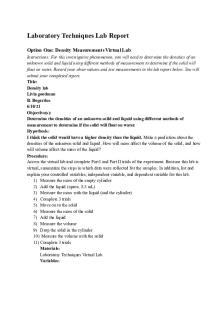
Laboratory Techniques Lab Report
- 4 Pages

Laboratory report for BIO
- 4 Pages
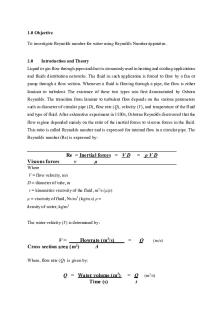
Reynold\'s Number Laboratory Report
- 11 Pages
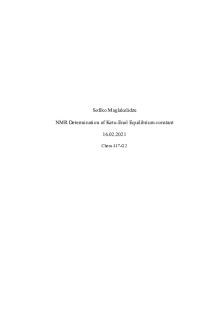
NMR Laboratory Report
- 17 Pages

Experiment 23 laboratory report
- 7 Pages

Laboratory WEEK 5 - guides
- 12 Pages
Popular Institutions
- Tinajero National High School - Annex
- Politeknik Caltex Riau
- Yokohama City University
- SGT University
- University of Al-Qadisiyah
- Divine Word College of Vigan
- Techniek College Rotterdam
- Universidade de Santiago
- Universiti Teknologi MARA Cawangan Johor Kampus Pasir Gudang
- Poltekkes Kemenkes Yogyakarta
- Baguio City National High School
- Colegio san marcos
- preparatoria uno
- Centro de Bachillerato Tecnológico Industrial y de Servicios No. 107
- Dalian Maritime University
- Quang Trung Secondary School
- Colegio Tecnológico en Informática
- Corporación Regional de Educación Superior
- Grupo CEDVA
- Dar Al Uloom University
- Centro de Estudios Preuniversitarios de la Universidad Nacional de Ingeniería
- 上智大学
- Aakash International School, Nuna Majara
- San Felipe Neri Catholic School
- Kang Chiao International School - New Taipei City
- Misamis Occidental National High School
- Institución Educativa Escuela Normal Juan Ladrilleros
- Kolehiyo ng Pantukan
- Batanes State College
- Instituto Continental
- Sekolah Menengah Kejuruan Kesehatan Kaltara (Tarakan)
- Colegio de La Inmaculada Concepcion - Cebu
